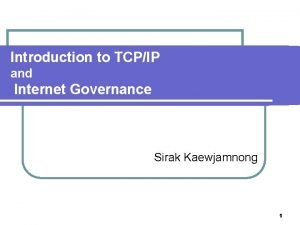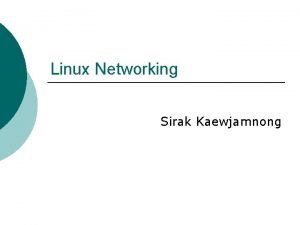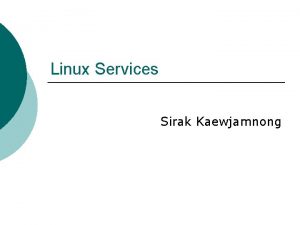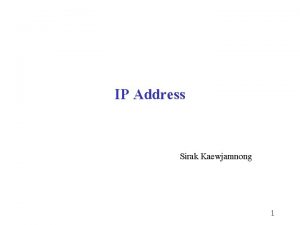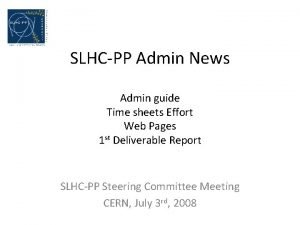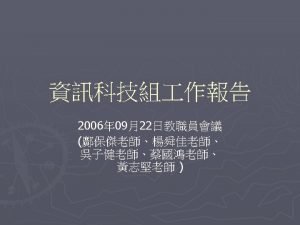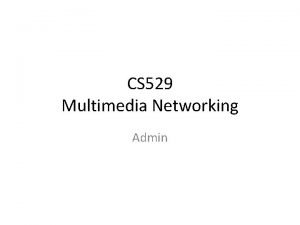Introduction to System Admin Sirak Kaewjamnong The system











![Change password ¡ User root changing the password for user paul [root@myhost]# passwd paul Change password ¡ User root changing the password for user paul [root@myhost]# passwd paul](https://slidetodoc.com/presentation_image/d46e51808ebe17c08f45739f1ba510ff/image-12.jpg)
![Delete user ¡ ] ¡ The userdel command is used to remove the user's Delete user ¡ ] ¡ The userdel command is used to remove the user's](https://slidetodoc.com/presentation_image/d46e51808ebe17c08f45739f1ba510ff/image-13.jpg)

- Slides: 14

Introduction to System Admin Sirak Kaewjamnong

The system administration’s job Adding a new user ¡ Doing backup and restoring files from backups ¡ Answer user questions ¡ Monitoring system activity and tuning system performance for good respond time ¡ Worrying about system security and patching security holds ¡ 2

The system administration’s job Installing programs and OS updates ¡ Trying to free up disk space ¡ Rebooting the system after a crash ¡ Adding a new equipment and new systems ¡ Fixing any problems ¡ Writing scripts to automate as many of the above activities as possible ¡ 3

Unix superuser Superuser is a privileged account with unrestricted access to all files and command ¡ The user name of superuser is “root” ¡ This user has a user ID of 0 ¡ 4

Becoming root ¡ There are two ways to become the superuser 1. 2. Login as root directly Execute command su to change privileged 1. %su 5

Sudo command ¡ ¡ The sudo utility allows users defined in the /etc/sudoers configuration file to have temporary access to run commands they would not normally be able to due to file permission restrictions Sudo (superuser do) allows a system administrator to give certain users (or groups of users) the ability to run some (or all) commands as root 6

The /etc/sudoers File ¡ The /etc/sudoers file contains all the configuration and permission parameters needed for sudo to work 7

Format of the /etc/sudoers File usernames/group servername = (usernames command can be run as) command ¡ Groups are the same as user groups and are differentiated from regular users by a % at the beginning. The Linux user group "users" would be represented by %users. ¡ can have multiple usernames per line separated by commas. ¡ Multiple commands also can be separated by commas. Spaces are considered part of the command. ¡ The keyword ALL can mean all usernames, groups, commands and servers. ¡ If run out of space on a line, admin can end it with a back slash () and continue on the next line. ¡ The NOPASSWD keyword provides access without prompting for your password. 8

/etc/sudoers Examples root %wheel ¡ ALL = (ALL) ALL root and users in group wheel can run anything on any machine as any user Srk, rp ¡ ALL = (ALL) ALL = NOPASSWD: ALL User srk and rp can run anything on any machine without a password peter, %operator ALL= /sbin/, /usr/sbin, /usr/local/apps/check. pl ¡ user peter and all the members of the group operator to gain access to all the program files in the /sbin and /usr/sbin directories, plus the privilege of running the command /usr/local/apps/check. pl 9

Using Aliases in the sudoers File User_Alias ADMINS ¡ ¡ User alias ADMINS are user millert. mikef, dowdy User alias ADMINS can run anything on any machine without a password Cmnd_Alias srk ¡ ADMINS = millert, mikef, dowdy ALL = NOPASSWD: ALL PRINTING = /usr/sbin/lpc, /usr/bin/lprm SHUTDOWN = /usr/sbin/shutdown ALL = PRINTING, /usr/bin/adduser User srk can use printer and add new user 10

How to add user Add linux group #groupadd students #groupadd staff #groupadd teachers ¡ Add the Linux users and assign them to their respective groups #useradd –g teachers rp #useradd –g staff srk ¡ ¡ Each user's personal directory is placed in the /home directory. The directory name will be the same as their user name 11
![Change password User root changing the password for user paul rootmyhost passwd paul Change password ¡ User root changing the password for user paul [root@myhost]# passwd paul](https://slidetodoc.com/presentation_image/d46e51808ebe17c08f45739f1ba510ff/image-12.jpg)
Change password ¡ User root changing the password for user paul [root@myhost]# passwd paul Changing password for user paul. New password: Retype new password: passwd: all authentication tokens updated successfully. [root@myhost]# 12
![Delete user The userdel command is used to remove the users Delete user ¡ ] ¡ The userdel command is used to remove the user's](https://slidetodoc.com/presentation_image/d46e51808ebe17c08f45739f1ba510ff/image-13.jpg)
Delete user ¡ ] ¡ The userdel command is used to remove the user's record from the /etc/passwd and /etc/shadow used in the login process. The command has a single argument, the username root@myhost]# userdel paul an optional -r switch that additionally removes all the contents of the user's home directory [root@myhost]# userdel -r paul 13

¡ http: //www. sudo. ws/sudo/sample. s udoers 14
 Hình ảnh bộ gõ cơ thể búng tay
Hình ảnh bộ gõ cơ thể búng tay Frameset trong html5
Frameset trong html5 Bổ thể
Bổ thể Tỉ lệ cơ thể trẻ em
Tỉ lệ cơ thể trẻ em Gấu đi như thế nào
Gấu đi như thế nào Glasgow thang điểm
Glasgow thang điểm Chúa yêu trần thế
Chúa yêu trần thế Các môn thể thao bắt đầu bằng tiếng đua
Các môn thể thao bắt đầu bằng tiếng đua Thế nào là hệ số cao nhất
Thế nào là hệ số cao nhất Các châu lục và đại dương trên thế giới
Các châu lục và đại dương trên thế giới Công thức tiính động năng
Công thức tiính động năng Trời xanh đây là của chúng ta thể thơ
Trời xanh đây là của chúng ta thể thơ Cách giải mật thư tọa độ
Cách giải mật thư tọa độ Làm thế nào để 102-1=99
Làm thế nào để 102-1=99 Phản ứng thế ankan
Phản ứng thế ankan















